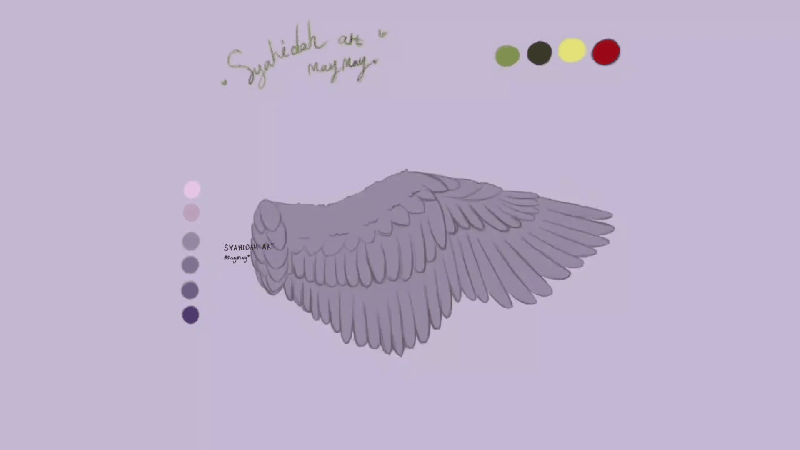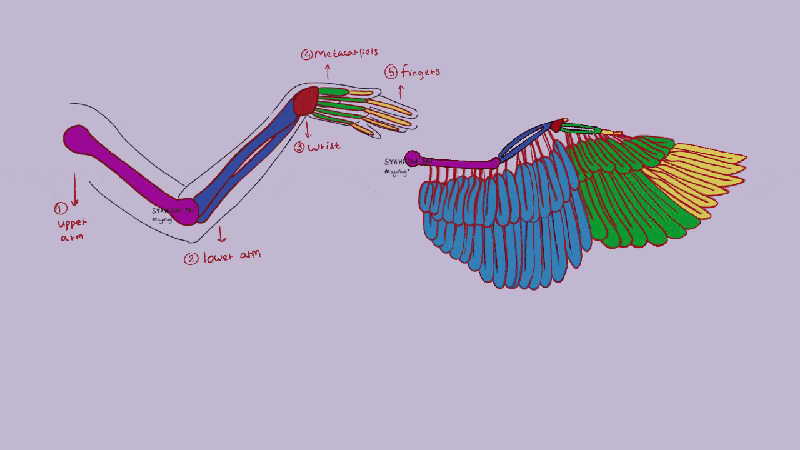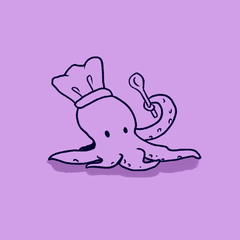How I illustrate different types of wings | Tips
INTRODUCTION:
Hello 🌷,
I'm May and I sincerely hope for everyone an enjoyable day.
In this art tutorial I'm gonna explain a step by step tips on how I illustrate a different types of wings especially for a fantasy themed art and illustration.
Here's the video version of this tutorial, feel free to look into it 🌙:
Wings are absolutely mesmerising and important in creating a stunning and magical illustration, as well as characters.
There are three types of wings that I will mainly focused on for current tips of the month:
Feathered Wings, Webbed Wings and Membranous Wings.
TYPES OF WINGS:
I'll be using Clip Studio Paint app for these tutorial>
- these are the brushes that I'll be using for sketching and colouring

• FEATHERED WINGS
Birds are animals with feathered wings,
In a fantasy world, these types of wings are commonly called an angel-like wings.
• WEBBED WINGS
Webbed or membrane wings are flexible, thin, and has an elastic stretched skin structure.
Such as bats and pterosaurs,.
In a fantasy world these wings are usually termed as demon-like wings or a dragon wings.
• MEMBRANOUS WINGS
Flies and insert wings are mostly membranous, it has a fairy-like wings.
These types of wings are thins and mostly transparent.
WINGS BASIC STRUCTURE CHARACTERISTIC:
♡ FEATHERED WINGS
• THE LAYERS:
Bird wings originally had many layers.
To understand it easier, I'll divide it into (3) sections.
- 1st section:
Scapulars; are body feathers that cover the top (the base) of the wing when the bird is resting.
- 2nd section:
Secondary feather (secondaries); are inner wing feathers.
- 3rd section:
Primary feather (primaries); are outer wing feathers.
Secondaries and Primaries are devided into three layers each:
Secondaries: marginal coverts, secondary coverts and secondary feathers.
Primaries: alula, primary coverts and primary feathers.
• THE BONE STRUCTURE:
To understand it easier, let's focus on the similarity between bird wings and human arms' structure.
The difference between them it's mostly the hands' structure, especially the fingers.
The bone lines (arm) position will determine the feathers placement.
• 5 TYPES OF FEATHERED WINGS:
1. Active soaring
long and narrow
great for flying with flapping
example: gulls and gannets
2. Passive soaring
long and broad
shorter than active soaring wings, but wider
long primary feather with wide gaps in between
example: Eagles
3. Elliptical
rounde and wide
usually slow and require flapping
quick at taking off
example: sparrows and hawks
4. High-speed
medium long and narrow
optimised long term speed
fast flying birds
example: falcons and swifts
5. Hoovering
small, but long body proportion
great for controlled flight
fast and quickly flapping wings
example: humming birds
♡ WEBBED WINGS
Bat wings are mostly thin elastic skins supported by bones.
• THEBONE STRUCTURE:
It's possible to use the human hand structure for bat wings as well,
Because, bird and bat wings (bone) structure are similar.
• 2 TYPES OF BAT WINGS:
Long and narrow (wingspan aspect ratio)
Short and broad (wingspan aspect ratio)
♡ MEMBRANOUS WINGS
• BUTTERFLY AND INSECT WINGS STRUCTURE:
Butterfly or insect wings are mostly devided by two:
1. Forewing : setup as the main power for the flight.
2. Hindwing : setup as the support power for the flight .
Each of these wings contains:
cells
veins to pump up the wing for flight; because it lacks bones.
tails on hindwing area; on some insect such as Butterfly .
• DIFFERENT TYPES OF INSECT WINGS:
For example:
dragonfly wings are long and narrow.
bee wings are small, pointy beginning and rounded end.
butterfly wings are wide and commonly has many printed patterns.
SIMPLE STEP BY STEP; TIPS ON HOW TO DRAW WINGS:
♡ WINGS' SHAPE AND STRUCTURE
• FEATHERED WINGS:
Starting by drawing an oval shape for the scapulars.
Then, draw the shape for secondaries and divide it into three parts :
marginal coverts, secondary coverts and secondary feathers.
- the bottom part is longer or larger; because the secondary feathers are larger than the rest secondaries since its far to the wings bone or arms.
next, draw the primary feather (the size is pointer and smaller than the secondaries).
divide the primaries into three part as well: alula, primary coverts and primary feathers.
make up three points for the joints: shoulder, elbow and wrist.
Connecting it to draw an arm shape for wings bone.
Let's draw the feathers,
the scapular is typically buffer than the rest
the secondaries edges are commonly rounded and smaller in size if it's closer to the wing bone.
the primaries tip are pointer.
More explanation below.
Here's the time-lapse video of it:

- The primary feathers toward the wingtip are longer and pointy.
It's attached to the wing hand.
While, the secondary feathers toward the elbow are rounded and shorter.
The feathers that closer toward the arm bone are smaller; such as coverts and alula.
The scapular feathers typically are buffer; it acts as a body shield.
• WEBBED WINGS:
Start with the structure of an arm.
Next, add hooked thumb and Long fingers extended into wings membrane.
Draw webbing around it and shape it.
Then, add claws on each finger.
Draw membranes' lines, wrinkles and veins.
• MEMBRANOUS WINGS:
Simple step by step:
draw an egg shapes for the forewing and hindwing.
add tiny circles on the hindwing for the spots later.
next, long oval shape on hindwing for the tail.
now, for the cells add circular shapes, sometimes oval or uneven circle shape on both forewing and hindwing.
draw lines around it, it's the veins.
-lastly, draw patterns and spots for butterfly wings or leave it transparent for other insect wimgs such as bee or dragonfly.

Here's how I drew bee wings (time-lapse version):

♡ HOW I COLOUR DIFFERENT TYPES OF WINGS
The steps that I mostly go through for colouring are:
setting a soft coloring for the base
use a darker shade for shading (Use monochromatic or analogues of colour wheel)
use a lighter shade for highlight (Use monochromatic or analogues of colour wheel)
blend the colours using low opacity strokes
keep repeating the steps, gradually change the colours with analogues (next to) of the colour wheel
when blending, gradually add a vibrant colour to it
add textures for rendering
- "multiply" with a low opacity, using a
(complementary, triadic or analogues of the colour wheel) for shadow
- "overlay" with a low opacity, using the previous colour to make the shadow less dull
- "add" glow with a low opacity, using a
(complementary, triadic or analogues of the colour wheel) for lighting
- "overlay" with a low opacity, using a
(complementary, triadic or analogues of the colour wheel) for the reflected lights
- keep blending until satisfied

Using these types of colour wheel helps with choosing and picking the colour that works well together: analogues, tradic, monochromatic, complementary.
Here's how I'm blending the colours by using soft rounded brush,
Take two colours in different shades, then add the colour on top of the other colours with low opacity.
Take the mixed colours, and keep adding and blending it using this technique.

THE MOTION AND MOVEMENT OF WINGS:
♡ WHEN FLYING
wings flaps to move forward quicker
( up and down motion ) and create more lift to push the air down for flight.
Each wings has their own repeated motions and movements that help push air under their wing.
By these structure and idea;
Here's how different types of wings might fly:
Imagine holding a piece of paper right in the middle, then flapp it slowly.
The motion and movement are a bit similar with the way wings flaps.
bird wings looks softer and bat wings looks sharper it might be the long fingers.
While insect wings look like it's in between, because I personally felt it doesn't look as soft as the way bird flaps because birds has a soft feathers.
And, also not as sharp as bat, because it doesn't have a bone.
Insects flap their wings with muscles.



♡ WHEN FOLDING
• FEATHERED WINGS:
Used a similar concept as this folded vertical blinds.
on the outside view, the primary feather are covered by the rest of the wing when it's folded.
It goes hiding behind the secondary feathers.
While scapulars cover the base.
It's also has a similarity with this folded fan.
Since human arms, bird wings and bat wings has three similar joints: shoulder, elbow and wrist.
By folding or bending human arm's structure, it could help with the visualisation on how to fold bird and bat wings.
- outside view on the left and inside view on the right >


•WEBBED WINGS:
Used a similar concept as this folded curtain or even closer toward an umbrella.
When webbed wings folded, the membrane skin between bones is wrinkled.
It's important to add wrinkles and textures to the folded area of the membrane when the wing is folding


• MEMBRANOUS WINGS:
Butterfly or insects usually fold their wings along their backs when resting.
Used a similar concept as this folded vertical blinds or flipped knife,
The forewing is hiding behind the hindwing when resting (inside view).

Pushing the forewing down like this:
- when folding or resting, ( inside view )
*The hindwing will automatically moves (lowered) a bit as well.

- the forewings are typically cover the hindwing (on the outside view),
but when the wings are standing up while folding, the hindwing will be visible.
*the folding is done by the abdomen and forewing activity together by pushing the wings under the forewing (outside view).

Conclusion:
(Inside view) hindwing visible
(Outside view) forewing visible
*Forewing movement when resting is covering the hindwing,
*Unless the wings are standing up (folded), in this case the hindwing will be visible.
TIPS FOR A FANTASY THEMED ILLUSTRATION; WINGED CHARACTERS:
♡ WINGS' PLACEMENT
Wing can be placed anywhere according to our imagination, while still considering the aesthetic norm and adding the magical touches.
for example:
- anywhere around the back area.
- I'll be using the 3d figure on Clip Studio Paint App, to help with the poses and character perspective:
or even ...
- above ears,
It's an extraordinary place for a wing, but it's definitely fun to experiment with where to places it.
- four other examples are more detailed where the wings are placed and connected on the bone area:
1. Scapular; on the shoulder area: Its the classic way of wings are commonly placed.
2. Anywhere on the rib cage bones, typically for fairies.
But fantasy has no limitations. Feel free to experiment.
3. Spin bones,
Here is how I placed insect wings such as dragonfly wings on the spine area.
4. Iliac crest,
Another example for an interesting place to put wings for winged characters.
♡ CREATIVITY; UNIQUE SHAPES OF WINGS
There aren't any limitations in a fantasy world, especially when it comes to colours and shapes.
It is welcomed to broadly develop our imagination far from reality.

- add longer feathers in each primaries and secondaries at the tip or inner part of the wings for a fantasy vibes.
Weebed wings shapes are interesting,
It's possible to add more fingers or even use less fingers.
Different shapes of the membrane skin, add value and torn.
draw a longer or shorter claws.

more examples with my previous winged character illustrations:
The first picture is a tiny bee wings 🐝 placed on the head area.
the second picture is a fairy with leaves 🍃 as her wings.
the third picture is a fairies 🧚♂️ with their triple pointed wings.
My favourite things to Illustrate for a fantasy themed illustration is making things from plants or flowers.
Let's take an example of a leaf in the illustration of wings:
Reform and draw different types of wings using leave patterns.
*or using flower petals, such as sunflowers and tulips as fairy-like wings .
♡ ADDING EXTRAORDINARY GLOW AND COLOURS
The colours play a huge role in making winged fantasy characters,
as well as determine it character or behaviour.
"ADD" GLOW a bright colour using sparkle brush.
"COLOR DODGE" a bright colour using a glitter brush.
Then, radical blur on the glitter.
*I'll be using the (effect) brushes on Clip Studio Paint app for these:
Adding lighting and glows to liven up the atmosphere.
Click "edit"
Tonal correction > hue/ saturation/ luminosity Colour balance
*For setting the colour hue, balance and curves, to enchanting, changing and experimenting on the colours. (Duller, faded or more vibrant):
hue: to change the original colour by changing the pigments.
colour balance: to change each of the colour (specifically red, green and blue tones) RGB.
Keep experimenting with the colours, and let the imagination run freely.
CONCLUSION:
Even though fantasy art is limitless, to illustrate fantasy themed art; collecting information as well as references are important to express ideas and deep imagination, creating it by combining both.
Thank you for reading,
I hope these tips could help and inspire you more 🌷 ~























Comment